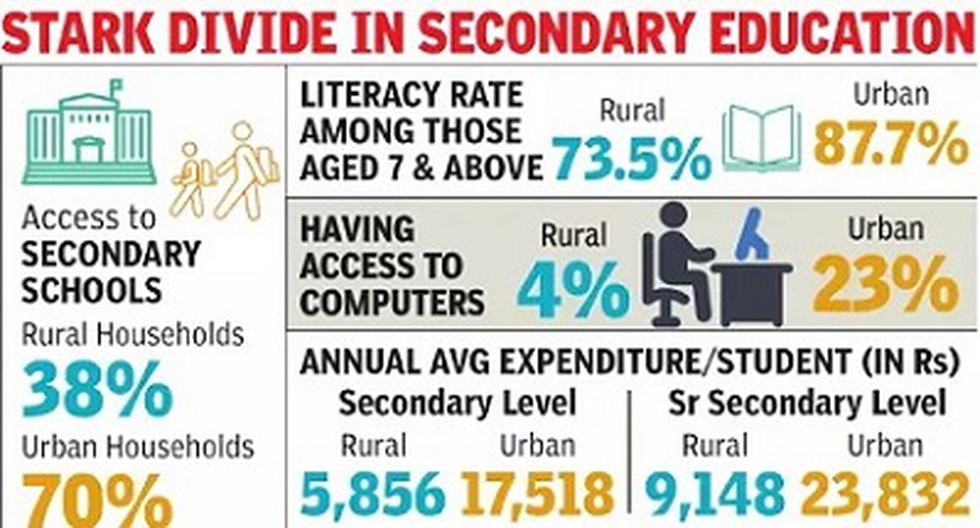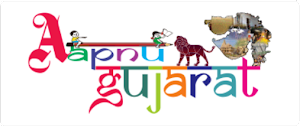NSO REPORT ON HOUSEHOLD SOCIAL CONSUMPTION: EDUCATION
The National Statistical Office (NSO) released a report on “Household Social Consumption: Education” in which it surveyed 1.13 lakh households spread across over 8,000 villages and 6,000 urban blocks between July 2017 and June 2018.

Key Findings:
- The rural-urban gap remains significant in literacy, accessibility to schools and household expenditure on education.
- On Accessibility to schools, 92.7% of the rural households have a primary school within 1 km as compared to 87.2% in urban areas. But only 38% of the rural household have access to secondary school as compared to 70% in the urban areas on similar parameters.
- The all India literacy rate among persons aged 7 years and above is 77.7%. However, for the same age group, the rural literacy is 73.5% and in the urban areas it is 87.7%.
- There is a digital divide, too, with just 4% of the rural households having access to computers as compared to 23% in urban areas. While 15% surveyed population in the rural cluster has internet access, 42% of the surveyed students in the urban areas have access to the internet.
- Annual average expenditure per student at secondary and senior secondary level in a rural household stands at Rs 5,856 and Rs 9,148 respectively. An urban household for the same classes spends Rs 17,518 and Rs 23,832 respectively.
- Around 76% of the rural children are attending primary and middle school run by the government, while only 38% of the urban children are attending government schools and instead prefer private schools.
The National Sample Survey’s 75th round was conducted between June 2017 and July 2018 in which households were surveyed on consumption related to education. Recently, the final report was published which shows that 19.8% of students at all levels from pre-primary to graduate students take some form of private coaching. More than 30% of students of Class 9 and 10 starts preparing for the crucial board exams and admission tests.
According to the National Statistical Organisation’s (NSO) latest report on Education, one in five students in India supplements school education with private coaching, including almost one in three at the secondary school level or Classes 9 and 10.
The fees make up for almost 20% of their total cost of education. Private coaching fees make up almost 20% of the total cost of education for those in secondary and higher secondary school. In some states like West Bengal, students spend more on private coaching than on their regular school.
Due to COVID-19 pandemic regular schools, coaching and tuition classes have also been closed. Some of them may be conducting online coaching classes. As per the guidelines issued by the Health Ministry from 21 September, 2020, schools will be partially reopened on a voluntary basis for Class 9 to 12 students.
About the Survey
– This is the 6th survey related to social consumption to education. Earlier on this subject, 35th, 42nd, 52nd, 64th, and 71st rounds had surveyed. From January-June 2014, 71st round took place.
– From all over India, a sample of 64,519 rural households from 8,097 villages and 49,238 urban households from 6,188 blocks was surveyed.
– Both the aspects whether qualitative or quantitative related to the educational attainment of the household members and educational services used by them are covered.
Key findings of the Report:
1. Internet access: According to the National Statistical Organisation Survey on Digital Education Divide, there is a major digital divide within the country across the states, cities and villages, and income groups.
– About 4% of rural households and 23% of urban households possessed computers.
– In the country, 24% of households had internet access.
– Persons of age groups from 15 to 29 years, nearly 24% in rural areas and 56% in urban areas were able to operate a computer.
2. Education and Literacy Rates:
In India 77.7% of the literacy rate among persons aged 7 years and above. In rural areas, it is 73.5% as compared to urban areas that is 87.7%, as per the reports on Literacy Rate.
– Literacy rate of Male was higher (84.7%) than female (70.3%).
– In rural areas, only 5.7% were graduates or above and in urban areas 21.7%.
3. Type of education, Access to schools and Attendance
Within 1 km of the house, only 38% of rural households have secondary schools as compared to 70% for urban households.
– Primary school within 1 km from the house: In rural areas 92.7% of households and in urban areas 7.2% of households.
– 96.1% of students were in general education and remaining was in technical/professional education.
– In rural and urban areas, Gross Attendance Ratio (GAR) at the primary level was nearly 100% for both males and females.
4. Free education, Scholarships, Stipends:
Nearly 14% of students attending formal education received scholarship/ stipend/ reimbursement at all-India level.
– Students around 77% studying in Government institutions were receiving free education.
– In rural areas, students studying in private unaided institutions and receiving free education was nearly 2% and in urban areas 1%.
– In India, at a pre-primary level, nearly 33% of students were getting free education. And at primary level, the proportion of students receiving free education was 62%.
5. Household expenditure on education:
– During the current academic session (2017-18), average expenditure per student incurred for basic courses was nearly Rs. 8,331 for general courses, Rs. 50,307 for technical/professional courses.
– For secondary school students, the average annual expenditure on education is Rs 9,013, of which Rs. 4,078 goes towards regular school fees.
– About Rs. 1,632, or just over 18%, goes towards private coaching. n higher secondary school, students spend more than Rs. 2,500, also about 18% of the total expenditure, on private coaching.
6. Private Coaching’s:
In India, nearly 20% of students attending pre-primary and above level were taking private coaching.
At the secondary level, the incidence of taking private coaching was maximum that is 31% of male students and 29% of female students.
7. Those persons who are not currently attending education:
– Percentages of persons in the age group of 3-35 years in India are dropping out of studies that were nearly 14% in rural areas and 10% in urban areas.
– The most common reason for not attending education for the males of age 3-35 years is engaged in economic activities and for females, it was an engagement in domestic activities.
Note: This topic can be asked in UPSC GS paper 2.
According to the National Statistical Organisation’s (NSO) latest report on Education, one in five students in India supplements school education with private coaching, including almost one in three at the secondary school level or Classes 9 and 10.
The fees make up for almost 20% of their total cost of education. Private coaching fees make up almost 20% of the total cost of education for those in secondary and higher secondary school. In some states like West Bengal, students spend more on private coaching than on their regular school.
Due to COVID-19 pandemic regular schools, coaching and tuition classes have also been closed. Some of them may be conducting online coaching classes. As per the guidelines issued by the Health Ministry from 21 September, 2020, schools will be partially reopened on a voluntary basis for Class 9 to 12 students.
About the Survey
– This is the 6th survey related to social consumption to education. Earlier on this subject, 35th, 42nd, 52nd, 64th, and 71st rounds had surveyed. From January-June 2014, 71st round took place.
– From all over India, a sample of 64,519 rural households from 8,097 villages and 49,238 urban households from 6,188 blocks was surveyed.
– Both the aspects whether qualitative or quantitative related to the educational attainment of the household members and educational services used by them are covered.
Key findings of the Report:
1. Internet access: According to the National Statistical Organisation Survey on Digital Education Divide, there is a major digital divide within the country across the states, cities and villages, and income groups.
– About 4% of rural households and 23% of urban households possessed computers.
– In the country, 24% of households had internet access.
– Persons of age groups from 15 to 29 years, nearly 24% in rural areas and 56% in urban areas were able to operate a computer.
2. Education and Literacy Rates:
In India 77.7% of the literacy rate among persons aged 7 years and above. In rural areas, it is 73.5% as compared to urban areas that is 87.7%, as per the reports on Literacy Rate.
– Literacy rate of Male was higher (84.7%) than female (70.3%).
– In rural areas, only 5.7% were graduates or above and in urban areas 21.7%.
3. Type of education, Access to schools and Attendance
Within 1 km of the house, only 38% of rural households have secondary schools as compared to 70% for urban households.
– Primary school within 1 km from the house: In rural areas 92.7% of households and in urban areas 7.2% of households.
– 96.1% of students were in general education and remaining was in technical/professional education.
– In rural and urban areas, Gross Attendance Ratio (GAR) at the primary level was nearly 100% for both males and females.
4. Free education, Scholarships, Stipends:
Nearly 14% of students attending formal education received scholarship/ stipend/ reimbursement at all-India level.
– Students around 77% studying in Government institutions were receiving free education.
– In rural areas, students studying in private unaided institutions and receiving free education was nearly 2% and in urban areas 1%.
– In India, at a pre-primary level, nearly 33% of students were getting free education. And at primary level, the proportion of students receiving free education was 62%.
5. Household expenditure on education:
– During the current academic session (2017-18), average expenditure per student incurred for basic courses was nearly Rs. 8,331 for general courses, Rs. 50,307 for technical/professional courses.
– For secondary school students, the average annual expenditure on education is Rs 9,013, of which Rs. 4,078 goes towards regular school fees.
– About Rs. 1,632, or just over 18%, goes towards private coaching. n higher secondary school, students spend more than Rs. 2,500, also about 18% of the total expenditure, on private coaching.
6. Private Coaching’s:
In India, nearly 20% of students attending pre-primary and above level were taking private coaching.
At the secondary level, the incidence of taking private coaching was maximum that is 31% of male students and 29% of female students.
7. Those persons who are not currently attending education:
– Percentages of persons in the age group of 3-35 years in India are dropping out of studies that were nearly 14% in rural areas and 10% in urban areas.
– The most common reason for not attending education for the males of age 3-35 years is engaged in economic activities and for females, it was an engagement in domestic activities.
Note: This topic can be asked in UPSC GS paper 2.
